Abstract
The introduction of fluorophores into RNA for both in vitro and in cellulo studies of RNA function and cellular distribution is a subject of great current interest. Here I briefly review methods, some well-established and others newly developed, which have been successfully exploited to site-specifically fluorescently label interior positions of RNAs, as a guide to investigators seeking to apply this approach to their studies. Most of these methods can be applied directly to intact RNAs, including (1) the exploitation of natural posttranslational modifications, (2) the repurposing of enzymatic transferase reactions, and (3) the nucleic acid-assisted labeling of intact RNAs. In addition, several methods are described in which specifically labeled RNAs are prepared de novo.
1. Introduction
The introduction of fluorophores into RNA for both in vitro and in cellulo studies of RNA function and cellular distribution is a subject of great current interest. Excellent comprehensive reviews have recently been published on the synthesis of fluorescent analogs of nucleosides [1,2,3,4,5], and on the introduction of fluorescent probes into RNA by chemical and/or enzymatic procedures [6,7,8,9], which include descriptions of the utilization of changes in fluorescence to elucidate biological, biochemical and biophysical mechanisms. Against this background, my goal in writing this chapter is to briefly review methods, some well-established and some newly developed, that have been successfully exploited to site-specifically fluorescently label interior positions of RNAs, as a guide to investigators seeking to apply this approach to their studies.
2. Exploitation of Natural Posttranslational Modifications
There are more than 100 known posttranscriptional modifications of tRNAs [10]. Of these, four are pertinent for this review. Wybutosine is fluorescent, and dihydrouridine (DHU), 3-amino-3-carboxypropyluridine, acp3U, and 4-thiouridine, s4U can be derivatized with appropriately reactive fluorophores, as described below.
2.1. Wybutosine
The fluorescent nucleoside wybutosine, or its derivative hydroxy-wybutosine (Figure 1), is found uniquely at position 37 of eukaryotic tRNAPhes [11,12]. Wybutosine fluorescence in yeast tRNAPhe is environmentally sensitive [13,14]. This property has been exploited in measuring yeast tRNAPhe binding to various ligands [15,16] and in elucidating reaction mechanisms during ribosome-catalyzed polypeptide synthesis [17,18]. However, wybutosine’s comparatively low extinction coefficient (ε310–315 ~ 4000) [19,20] and low quantum yield (0.07) [13] limit its general utility as a fluorescence probe.
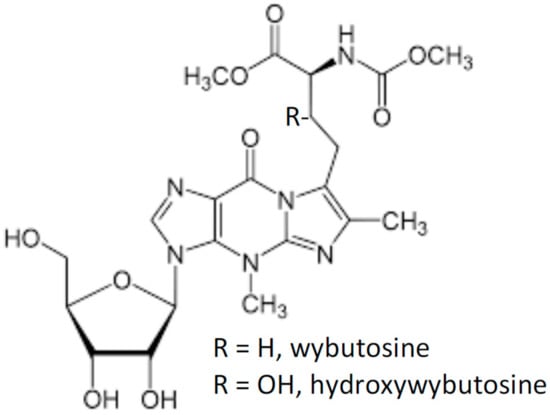
Figure 1.
Wybutosines, guanosine derivatives.
2.2. DHU
DHU is formed by post-transcriptional reduction of uridine and is the most widespread modified base which can be straightforwardly labeled with fluorescent groups. Four dihydrouridine synthases (Dus1–Dus4) have been identified, which use NADPH as the external reductant that is coupled with an enzyme-bound FMN cofactor. Collectively the Dus enzymes are responsible for the presence of one or more DHUs in the d-loop of the overwhelming majority of tRNAs, located at positions 16, 17, 17a 20, or 20a [21], as well as the much rarer instances of DHU within the variable loop of some tRNATyrs [21]. One or more of the Dus enzymes appear to be responsible for most, if not all, of the DHUs recently found to be present at 143 sites within 125 fission yeast mRNAs [22]. A practical consequence is that DHU can be installed as a potential site for introduction of fluorophores not only into unmodified tRNA transcripts [23,24], but also for a wider variety of sites within RNAs in general.
Zachau and Wintermeyer and their co-workers demonstrated that NaBH4 reduction in DHU residues allowed covalent introduction of weak base NH2-containing fluorophore nucleophiles into tRNAs with substantial retention by the labeled tRNAs of protein synthesis activity. Their work made extensive use of proflavin derivatives of tRNA [25]. More recently rhodamine 110 [22,23] and hydrazide derivatives of both Cy dyes [26,27] and Alexa dyes [28] have been incorporated into tRNAs. Despite this rather extensive use of fluorescent tRNAs labeled at DHU positions, the precise chemistry of the reaction leading to fluorophore introduction into these positions was for a long time unclear. This situation was remedied by the demonstration that the labeling reaction proceeded via formation of tetrahydrouridine (THU), as shown in Figure 2 [29]. The second step in this scheme likely proceeds via a dehydration intermediate that is attacked by the weak base amine, in an overall general acid-catalyzed Michael addition.
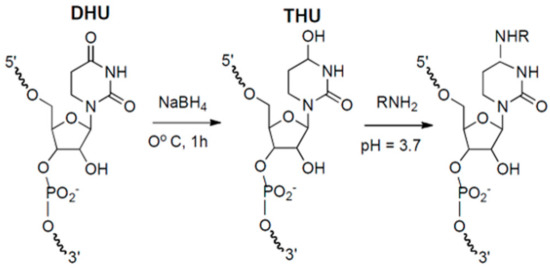
Figure 2.
Covalent modification of DHU via THU formation.
tRNAs fluorescently labeled via DHU chemistry have been used widely in in vitro ensemble [30,31,32] and single-molecule [33,34,35,36] studies of protein synthesis reaction mechanisms that exploit changes in fluorescence spectra, quantum yield, fluorescence anisotropy and/or FRET efficiencies. They have also found increasing use in intact cell studies, into which they are introduced via transfection [37], electroporation [38], microinjection [39] or rapid, pressure-induced generation of transient pores in cell membranes [28]. A common application has been for monitoring rates of protein synthesis. This approach is based on measuring the FRET intensities that are generated when a donor-labeled tRNA binds next to an acceptor-labeled tRNA in adjacent sites on an active ribosome. When bulk tRNA labeled with both donor and acceptor dyes is employed, the FRET signal provides a measure of overall protein synthesis [28,37,40,41,42,43]. In contrast, FRET signals that arise from ribosome-bound isoacceptor tRNA pairs which are cognate to specific mRNA dicodons measure synthesis of specific proteins [43,44,45]. Monitoring the movement of tRNAs within cells is a second application, and has been employed to measure tRNA diffusion rates in bacteria [38,46], tRNA trafficking between cytoplasm and nucleus in mouse embryonic fibroblasts [39], and dynamic mixing of tRNAs between neurite granules and rapid, bi-directional vectorial movement within neurites [41].
2.3. acp3U
A recently identified enzyme, tRNA U47 acp transferase A, abbreviated as TuaA, is responsible for modifying eight E. coli tRNAs, each at position 47 within the variable loop, by transfer of acp from S-adenosylmethionine (SAM) [47]. Two other enzymes also transfer acp from SAM to RNA: Tyw2/Trm12, which does so as an intermediate step in the synthesis of the tRNA wybutosine modification [48], and Tsr3 as part of the hypermodification of the yeast 18S rRNA U1191 to m1acp3 Ψ [49]. The amine group in acp is readily modified by amine-specific reagents, e.g., N-hydroxysuccinimide esters of Cy dyes [50]. The resulting fluorescent tRNAs have been used in single molecule studies of the mechanism of ribosome-catalyzed protein synthesis [51,52,53,54,55].
2.4. s4U
The tRNA modification enzyme ThiI, recently renamed tRNA thiouridine I, (TtuI) [56] catalyzes the ATP-dependent formation of 4-thiouridine, s4U, in bacteria and archaea, using cysteine as the ultimate sulfur donor, via a complex set of reactions. The s4U nucleoside is almost always found at position 8 of most bacterial and archaeal tRNAs. As TtuI modifies U8 of all bacterial tRNAs, there is no RNA sequence motif determining the specificity for U8 thiolation. Lauhon et al. [57] determined that a truncated tRNA consisting of 39 nucleotides (TPHE39A) mimicking the 3′-terminus, acceptor stem and T-stem loop of E. coli tRNA could serve as a minimal substrate for s4U8 synthesis (Figure 3). A subsequent structure of the TtuI-TPHE39A structure shows the enzyme recognizes the highly conserved 3′-ACCA end of tRNA and acts as a molecular ruler defining the length from the 3′-ACCA end to the site of modification [58], but successful efforts to further reduce substrate size have not yet been reported.
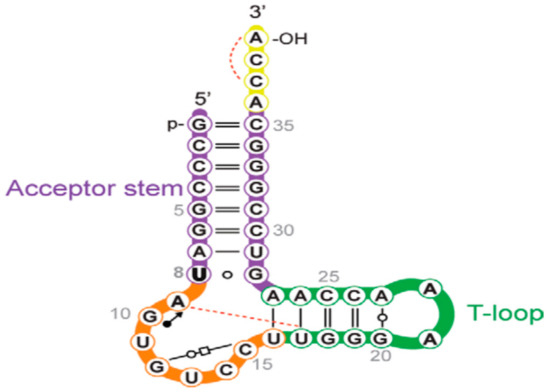
Figure 3.
Current minimal substrate for ThiI. Reprinted with permission from reference [58].
Cy-maleimides have been used to derivatize s4U, and the resulting fl-tRNAs have been used in single molecule studies of protein synthesis [50]. However, the yield of the derivatization reaction is quite low, due to the relatively poor reactivity of the 4-thione group toward maleimide. A more recent strategy for labeling s4U at much higher efficiency with exquisite specificity for s4U utilizes a two-step scheme in which the thione is first oxidized by periodate to the sulfonate, which is subsequently displaced by fluoresceinamine (FAM-NH2) [59].
2.5. Extensions beyond tRNA Labeling
It has generally been assumed that fluorescent labeling via DHU, acp3U, and s4U chemistry would be restricted to tRNAs. The recent demonstration that DHU is also found in many mRNA sites [22] raises the possibility that fluorescent labeling via DHU chemistry could be extended to other RNA targets. The potential of this approach will become clearer as the preferred secondary structure [60] and/or sequence contexts for DHU formation are defined. It is interesting to consider whether these recent results showing DHU presence in mRNAs will spur investigations not only into whether acp3U and s4U modifications are also present in RNAs other than tRNA, but also whether directed evolution of the enzymes involved in DHU, acp3U, and s4U formation would be successful in broadening substrate specificities [61].
3. Repurposing Enzymatic Transferase Reactions
Two recent reviews provide excellent overviews of the repurposing of enzymes to site-specifically label RNAs, at internal positions as well as at the 5′-mRNA cap and 3′-terminus [7,8]. Here we briefly present some points particularly pertinent to site-specific internal RNA position fluorescent labeling and highlight some very recent work published since these two reviews appeared.
3.1. SAM-Dependent Methyl Transferases (SAM-Mtases)
Several SAM-Mtases catalyze transfer reactions in which the sulfonium-bound methyl group is replaced with an extended side chain containing a functionality (amine, sulfhydryl, or click chemistry groups) which can be straightforwardly derivatized with commercially available fluorophore-containing reagents. This approach was first used to site-specifically place an AlexaFluor594 dye at the N2 of G26 in an S. cerevisiae tRNAPhe transcript by click chemistry, using the enzyme Trm1 that is specific for methylation at this position, and replacing S-Me with S-pent-2-en-4-ynyl [62]. An approach with potential for perhaps broader applicability is the use of SAM-Mtases with strong specificity for sequence contexts within mRNA. In a recent article Ovcharenko et al. [63] demonstrate the potential utility of two mRNA methyltransferases responsible for m6A formation, METTL3-14 and METTL16, which target the underlined A in the sequences GGACU and UACAGAGAA, respectively. Replacing the S-Me group in SAM with Se-propargyl affords relatively high yields of N6-propargylA (70–80% relative to S-Me) at targeted A residues within model RNAs 20–61 nts long, which are subsequently labeled by click chemistry with Cy5-azide. For METTL3-14, a similar strategy can be used to introduce photocaging groups (e.g., o-nitrobenzyl) at the N6 position. An important limitation of this approach is that these two SAM-Mtases can methylate sequences in addition to the most preferred sequences shown above. Thus, for example, METTL3-14 has broad specificity for DRACH sequences (D = A, G, or U; R = G or A; H = A, C or U), making it likely that, in general, several sites in long RNAs containing >150 nts will be targeted by this enzyme.
The enzyme, TrmA, methylates uridine-54 of the T-arm of tRNA, a 17-nucleotide stem loop (nts 49-65) which is structurally conserved and is the minimal substrate for the enzyme [64]. By mutating residues within the TrmA active site and using a high-throughput screen of substrate mutants, Smith et al. [65] identified a mutant TrmA that is unable to methylate a normal substrate derived from E. coli tRNAPhe, but is a good catalyst for methylating a variant substrate with altered residues in the loop region (nts 54-60). Given the ability of SAM-Mtases to tolerate replacement of the S-Me group with other alkylating agents, as described above, this alteration of specificity might have future utility for introducing fluorophores at selected RNA locations.
3.2. tRNA Guanine Transglycosylase (TGT)
Bacterial TGT has also been used to site- specifically label RNAs [66]. As shown in Figure 4, such labeling is achieved by incorporating a 17 nt TGT recognition element into the RNA of interest and using TGT to catalyze the transglycolysis reaction with labeled derivatives of preQ1, its natural substrate. Alkyl linkers have been successfully utilized to append various fluorescent probes to the preQ1 scaffold, including BODIPY, Cy5, Cy7 and thiazole orange.

Figure 4.
Site- specific TGT labeling of RNA. Reprinted with permission from reference [66].
4. Nucleic Acid-Assisted Labeling of Intact RNAs
4.1. RNA Acylation at DNA Induced Loops or Gaps
Xiao et al. [67] have introduced an appealingly simple approach which takes advantage of the low reactivity of RNAs in double-stranded DNA-RNA hybrids to use complementary DNA oligonucleotides to protect all but the desired reaction sites in an RNA, by creating loops or gaps as shown in Figure 5. The unprotected RNA nucleotide is then reacted in high yield with the water-soluble nicotinyl acylimidazole (NAI-N3), giving an acylated product suitable for further reaction via click chemistry with a suitable fluorophore partner. As a demonstration of the utility of the approach, a 65 nt small nucleolar RNA, SNORD78, was labeled successively with fluorophores at two different positions, Alexa488 at G14 and TAMRA at A49, generating a strong FRET signal. In this approach the sizes of the gaps can be varied, but the most site-specific modifications occur with a loop or gap size of one. Even here, however, small amounts of secondary acylation (20–30%) are found at the position adjacent to the targeted site. Further development of this approach will be needed to suppress such secondary acylation.
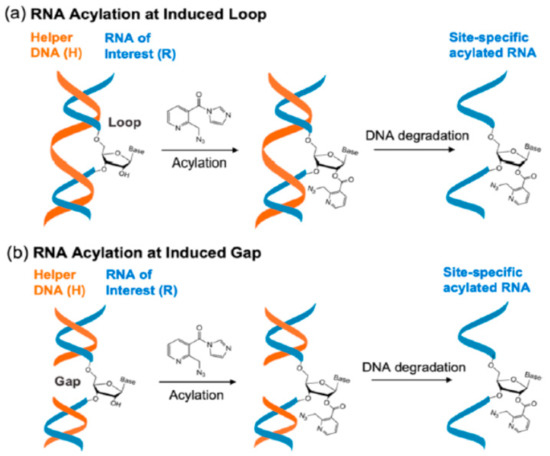
Figure 5.
Site-specific modification of RNA loops and gaps induced by DNA. Reprinted with permission from reference [67].
4.2. DNA Reactive Sequence Targeting of an Interior Adenosine
Zhao et al. [68,69] have developed a novel approach to specifically transfer an alkyne group to a specific adenosine residue, even one present in a double-stranded region, in a four step sequence. As illustrated in Figure 6, complementary DNA Helper sequences first unfold secondary structure neighboring the targeted A (step i). This is followed by hybridization with a complementary DNA Reactive Sequence derivatized with a precursor group at its 3′-terminus (step ii) and oxidative activation by periodate (step iii), permitting formation of a propargyl N1, N6–ethenoadenosine (step iv) which can be labeled by click chemistry with a fluorophor. Using this approach, two different A residues targeted within a 275 nt long riboswitch were labeled with yields of each dye derivatized site of between 14–17%. These values are markedly lower than an average value of ~65% which had been previously found for site-specific labeling of single-stranded RNA regions by the same methodology [70], an indication of the inherent difficulty of labeling double- stranded regions. Of note, the periodate oxidation step iii also oxidizes the RNA 3′-terminus to a dialdehyde, permitting its coupling with a second fluor by an orthogonal chemistry. This double labeling approach was used to generate FRET signals from labeled A residues targeted in both single-stranded [71] and double-stranded regions [68,69].
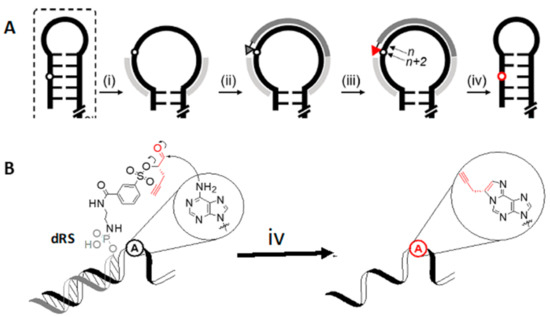
Figure 6.
(A). (i) DNA Helper Sequences (light gray) annealing, (ii) hybridization of DNA Reactive Sequence (dRS, dark grey) precursor, (iii) activation by sodium periodate, (iv) transfer of the reactive group and modification of an internal adenine. (B). Mechanism of reactive group transfer. Adapted with permission from Reference [68].
4.3. Evolving Ribozymes
Ghaem Maghami et al. [72] have recently demonstrated that the classic Selex approach of in vitro selection of random RNA libraries [73,74] can be used to evolve ribozymes capable of fluorescent labeling of specific interior RNA sites. The basic logic of this approach is illustrated in Figure 7. Once the 40 nt catalytic loop is optimized for labeling of a model sequence in cis, the recognition sequences can be altered to target any internal RNA nucleotide in trans. The attached reactive groups, amine, ethyne, or azide can be readily derivatized with fluorophores. This procedure has been applied to simple RNA sequences, giving yields of incorporated fluorophores of 50–80%. Substitution of tenofovir diphosphate in place of ATP resulted in formation of a more stable reaction product [75]. More complex RNAs, such as bacterial 5S rRNA and 23S rRNA, have been labeled site-specifically, although the yields of the labeling reactions were not indicated. Subsequent publications will presumably provide additional information for applications of this very promising approach.
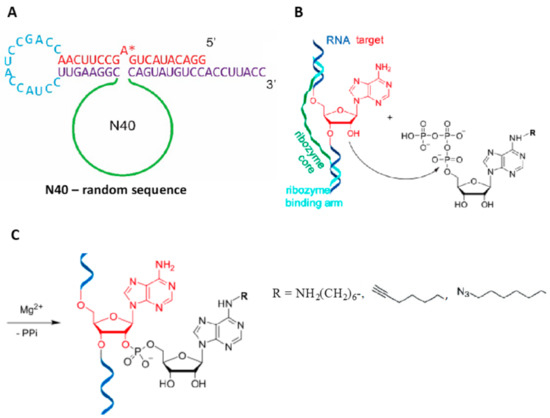
Figure 7.
(A). RNA catalysts for labeling of a specific adenosine (starred) within a model sequence in cis were identified from a partially structured random RNA pool (N40). The constant region of the RNA pool contained the hypothetical substrate sequence and a pair of recognition arms complementary to the substrate sequence. (B). The labeling reaction involving N6-substituted ATP adenylylating the 2’ hydroxyl of the targeted adenosine. (C). The product of reaction shown in B showing substitutions used for fluorophore labeling. Adapted with permission from reference [72].
5. Site-Specific Labeling Requiring De Novo RNA Preparation
5.1. Position-Selective Labeling of RNA (PLOR)
PLOR incorporates labels at specific positions of RNAs by combining solid-phase chemical synthesis with highly processive DNA-dependent RNA polymerases (RNAPs) to generate specifically labeled RNAs [76]. PLOR proceeds in three steps: initiation, elongation and termination. In the initiation stage, solid-phase DNA templates are mixed with RNAP, followed by initiation of transcription with the addition of three or fewer types of NTPs, leading to a transcription pause where the missing NTP type is required. Following removal of the residual initial NTPs by solid-phase extraction, an elongation cycle is begun by adding a new NTP mixture, again with three or fewer types of NTPs to resume transcription, which continues until the next point where the cognate NTP is absent. Each pause/resumption step (i.e., each elongation cycle) is controlled by the composition of the added NTPs. Various NTP combinations in each cycle allow incorporation of nucleotides with desired probes into specific positions of the transcript. In principle, this procedure allows modified or labeled NTPs to be introduced at multiple specific positions in nascent transcripts. Once the desired labeling is achieved, all four types of NTPs are added in the termination stage to complete the transcription. The DNA-bearing beads can be recycled after thorough rinsing.
In one application PLOR has been used to incorporate Cy3 and Cy5 into positions 24 and 55, respectively, of a 71nt adenine aptamer, permitting monitoring of the increase in FRET efficiency on adenine addition. The PLOR approach continues to be developed, most recently by optimizing linker sizes of DNA templates, the lengths and base composition of the RNA synthesized in the initiation stage, and methods for coupling fluorophores to modified nucleotides [77,78].
5.2. thG-Containing RNAs
Li et al. [70] have described the assembly of singly modified RNA constructs in which specific G residues are replaced with thG, shown in Figure 8, a highly fluorescent isomorphic guanosine analogue that preserves Watson-Crick base pairing and is available from TriLink Biotechnologies. The method relies on transcription in the presence of excess thG and native nucleoside triphosphates, which enforces initiation with the unnatural analogue. The resulting 5′-end modified transcripts are then mono-phosphorylated and ligated to provide longer site-specifically modified RNA constructs (Figure 8). This approach was used to replace G by thG, one at a time, at four positions within the active center loop region of a hammerhead (HH) ribozyme, with two of the four yielding active ribozymes, and with overall ligation yields of 20–40%. It will be interesting to see whether this method can be applied to other substituted guanosines, or to fluorescent analogues of other nucleosides.

Figure 8.
Formation of RNAs site-specifically labeled with thG. Reprinted with permission from reference [70].
5.3. Unnatural Base Pairs
The expansion of the genetic alphabet via the creation of a wide variety unnatural base pairs (UBPs) has been the object of a number of laboratories in recent years, as recently reviewed [79,80]. Site-specific labeling of RNAs is one application of these efforts, as illustrated in Figure 9. Some UBPs innately exhibit strong fluorescence and can used directly in experiments requiring a fluorescent probe [81,82]. The more general approach is to conjugate the X-base with a fluorophore. One example of this approach is provided by the work of Someya et al. [83] who report the fluorescent labeling of RNAs ranging in size from 17–260 nucleotides with high yields and specificity with the derivatized UBP shown in Figure 9B and subsequent click chemistry. Despite the elegance of this approach, it has not as yet been widely applied for RNA labeling because of the lack of commercially available unnatural RNA bases.
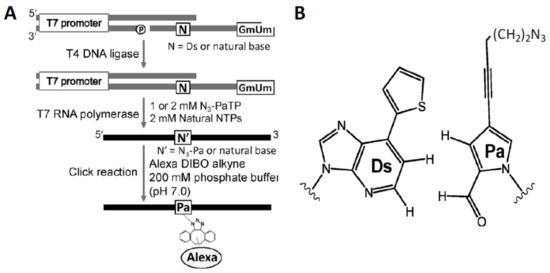
Figure 9.
(A). The scheme for site-specific incorporation of the unnatural base pair X(Pa)-Y(Ds) into first DNA and then RNA. (B). An azide derivative of Pa was used to site-specifically incorporate an Alexa dibenzocyclooctyne fluorophor into several different RNAs by click chemistry. Adapted with permission from reference [83].
6. Conclusions
As this review makes clear, there are many potential methods available for site-specific fluorescent labeling of RNA interior positions, so that the choice of which method to employ will typically depend on the size, sequence and structure of the targeted RNA. That said, it is worth considering whether any of the methods considered could become general, in the sense that it could be readily employed by most laboratories to any RNA of choice. At present, three methods come closest to this goal. Two of these, which label intact RNAs, are RNA acylation at DNA-induced loops or gaps (Section 4.1) and evolving ribozymes (Section 4.3). Each needs further optimization and a clearer demonstration of how well it performs with respect to yield and/or specificity on long, complex RNAs. Such developments should be forthcoming, given the underlying logic of these methods, and the fact that they have only been introduced within the last 1–2 years. In addition, the pause-and-restart PLOR method (Section 5.1) could well become the method of choice for preparing short (<100 nt) labeled RNAs, although its general usefulness for longer RNAs remains to be demonstrated. Two other methods, DNA reactive sequence targeting (Section 4.2), and unnatural base-pairing (Section 5.3), are technically quite impressive. However, each requires reactants which require some expertise in synthetic organic chemistry and are at present not commercially available, limiting their general adoption. The thG method (Section 5.2) has the enormous advantage of incorporating fluorescence with minimal perturbation of RNA structure, and likely can be applied to other fluorescent nucleosides. However, the dependence of this method on RNA ligation, a reaction with quite variable efficiency, could limit its generality. The other methods discussed in this review (Section 2.2, Section 2.3, Section 2.4, Section 3.1 and Section 3.2) each employ enzyme modification on intact RNAs to create sites for fluorescent labeling, with specific sequence and/or structure requirements for such modification to occur. Directed evolution of the modification enzymes could enlarge the pool of RNAs that could be site-specifically labeled by these methods, although it is unlikely that any of them would ever become general.
Funding
This work was supported by grants from NIH (GM127374) and the Cystic Fibrosis Foundation (COOPER18G0).
Conflicts of Interest
The author declares no conflict of interest.
References
- Sinkeldam, R.W.; Greco, N.J.; Tor, Y. Fluorescent analogs of biomolecular building blocks: Design, properties, and applications. Chem. Rev. 2010, 110, 2579–2619. [Google Scholar] [CrossRef]
- Xu, W.; Chan, K.M.; Kool, E.T. Fluorescent nucleobases as tools for studying DNA and RNA. Nat. Chem. 2017, 9, 1043–1055. [Google Scholar] [CrossRef] [PubMed]
- Saito, Y.; Hudson, R.H. Base-modified fluorescent purine nucleosides and nucleotides for use in oligonucleotide probes. J. Photochem. Photobiol. C. Photochem. Rev. 2018, 36, 48–73. [Google Scholar] [CrossRef]
- Bood, M.; Sarangamath, S.; Wranne, M.S.; Grøtli, M.; Wilhelmsson, L.M. Fluorescent nucleobase analogues for base–base FRET in nucleic acids: Synthesis, photophysics and applications. Beilstein J. Org. Chem. 2018, 14, 114–129. [Google Scholar] [CrossRef] [PubMed]
- Michel, B.Y.; Dziuba, D.; Benhida, R.; Demchenko, A.P.; Burger, A. Probing of Nucleic Acid Structures, Dynamics, and Interactions With Environment-Sensitive Fluorescent Labels. Front. Chem. 2020, 8, 112. [Google Scholar] [CrossRef]
- Klöcker, N.; Weissenboeck, F.P.; Rentmeister, A. Covalent labeling of nucleic acids. Chem. Soc. Rev. 2020, 49, 8749–8773. [Google Scholar] [CrossRef] [PubMed]
- Hanspach, G.; Trucks, S.; Hengesbach, M. Strategic labelling approaches for RNA single-molecule spectroscopy. RNA Biol. 2019, 16, 1119–1132. [Google Scholar] [CrossRef]
- Tomkuvienė, M.; Mickutė, M.; Vilkaitis, G.; Klimašauskas, S. Repurposing enzymatic transferase reactions for targeted labeling and analysis of DNA and RNA. Curr. Opin. Biotechnol. 2019, 55, 114–123. [Google Scholar] [CrossRef]
- George, J.T.; Srivatsan, S.G. Bioorthogonal chemistry-based RNA labeling technologies: Evolution and current state. Chem. Commun. 2020, 56, 12307–12318. [Google Scholar] [CrossRef]
- McCown, P.J.; Ruszkowska, A.; Kunkler, C.N.; Breger, K.; Hulewicz, J.P.; Wang, M.C.; Springer, N.A.; Brown, J.A. Naturally occurring modified ribonucleosides. Wiley Interdiscip Rev. RNA 2020, 11, e1595. [Google Scholar] [CrossRef]
- Itaya, T.; Kanai, T. Synthesis and structure of the hypermodified nucleoside of rat liver phenylalanine transfer ribonucleic Acid. Chem. Pharm. Bull. 2002, 50, 1318–1326. [Google Scholar] [CrossRef][Green Version]
- de Crécy-Lagard, V.; Brochier-Armanet, C.; Urbonavicius, J.; Fernandez, B.; Phillips, G.; Lyons, B.; Noma, A.; Alvarez, S.; Droogmans, L.; Armengaud, J.; et al. Biosynthesis of wyosine derivatives in tRNA: An ancient and highly diverse pathway in Archaea. Mol. Biol. Evol. 2010, 27, 2062–2077. [Google Scholar]
- Eisinger, J.; Feuer, B.; Yamane, T. Luminescence and binding studies on tRNA-Phe. Proc. Natl. Acad. Sci. USA 1970, 65, 638–644. [Google Scholar] [CrossRef] [PubMed]
- Beardsley, K.; Cantor, C.R. Studies of transfer RNA tertiary structure by singlet-singlet energy transfer. Proc. Natl. Acad. Sci. USA 1970, 65, 39–46. [Google Scholar] [CrossRef] [PubMed]
- Kirk, S.R.; Tor, Y. tRNA(Phe) binds aminoglycoside antibiotics. Bioorg. Med. Chem. 1999, 9, 1979–1991. [Google Scholar] [CrossRef]
- Dwyer, B.G.; Johnson, E.; Cazares, E.; Holman, K.L.M.; Kirk, S.R. Ruthenium anticancer agent KP1019 binds more tightly than NAMI-A to tRNAPhe. J. Inorg. Biochem. 2018, 182, 177–183. [Google Scholar] [CrossRef]
- Paulsen, H.; Robertson, J.M.; Wintermeyer, W. Effect of ribosome binding and translocation on the anticodon of tRNAPhe as studied by wybutine fluorescence. Nucleic Acids Res. 1982, 10, 2651–2663. [Google Scholar] [CrossRef]
- Robertson, J.M.; Paulsen, H.; Wintermeyer, W. Pre-steady-state kinetics of ribosomal translocation. J. Mol. Biol. 1986, 192, 351–360. [Google Scholar] [CrossRef]
- RajBhandary, U.L.; Faulkner, R.D.; Stuart, A. Studies on Polynucleotides LXXIX. Yeast phenylalanine transfer ribonucleic acid: Products obtained by degradation with pancreatic ribonucleasE. J. Biol. Chem. 1968, 243, 575–583. [Google Scholar] [CrossRef]
- Thiebe, R.; Zachau, H.G. A specific modification next to the anticodon of phenylalanine transfer ribonucleic acid. Eur. J. Biochem. 1968, 5, 546–555. [Google Scholar] [CrossRef]
- MODOMICS a Database of RNA Modifications. Available online: https://iimcb.genesilico.pl/modomics/ (accessed on 12 February 2021).
- Finet, O.; Yague-Sanz, C.; Kruger, L.K.; Migeot, V.; Ernst, F.G.; Lafontaine, D.L.J.; Tran, P.; Wéry, M.; Morillon, A.; Hermand, D. Transcription-Wide Mapping of Dihydrouridine (d) Reveals That Mrna ihydrouridylation is Essential for Meiotic Chromosome Segregation. Available online: http://dx.doi.org/10.2139/ssrn.3569550 (accessed on 15 February 2021).
- Betteridge, T.; Liu, H.; Gamper, H.; Kirillov, S.; Cooperman, B.S.; Hou, Y.M. Fluorescent labeling of tRNAs for dynamics experiments. RNA 2007, 13, 1594–1601. [Google Scholar] [CrossRef]
- Liu, C.; Betteridge, T.; Hou, Y.M. Fluorophore labeling to monitor tRNA dynamics. Methods Enzymol. 2009, 469, 69–93. [Google Scholar]
- Wintermeyer, W.; Zachau, H.G. Fluorescent derivatives of yeast tRNAPhe. Eur. J. Biochem. 1979, 98, 465–475. [Google Scholar] [CrossRef]
- Pan, D.; Qin, H.; Cooperman, B.S. Synthesis and functional activity of tRNAs labeled with fluorescent hydrazides in the D-loop. RNA 2009, 15, 346–354. [Google Scholar] [CrossRef]
- Stevens, B.; Chen, C.; Farrell, I.; Zhang, H.; Kaur, J.; Broitman, S.L.; Smilansky, Z.; Cooperman, B.S.; Goldman, Y.E. FRET-based identification of mRNAs undergoing translation. PLoS ONE 2012, 7, 38344. [Google Scholar]
- Tu, C.; Santo, L.; Mishima, Y.; Raje, N.; Smilansky, Z.; Zoldan, J. Monitoring protein synthesis in single live cancer cells. Integr. Biol. 2016, 8, 645–653. [Google Scholar] [CrossRef]
- Kaur, J.; Raj, M.; Cooperman, B.S. Fluorescent labeling of tRNA dihydrouridine residues: Mechanism and distribution. RNA 2011, 17, 1393–1400. [Google Scholar] [CrossRef]
- Pan, D.; Kirillov, S.V.; Cooperman, B.S. Kinetically competent intermediates in the translocation step of protein synthesis. Mol. Cell 2007, 25, 519–525. [Google Scholar] [CrossRef]
- Grigoriadou, C.; Marzi, S.; Kirillov, S.; Gualerzi, C.O.; Cooperman, B.S. A quantitative kinetic scheme for 70 S translation initiation complex formation. J. Mol. Biol. 2007, 373, 562–572. [Google Scholar] [CrossRef] [PubMed]
- Ng, M.Y.; Li, H.; Ghelfi, M.D.; Goldman, Y.E.; Cooperman, B.S. Ataluren and aminoglycosides stimulate read-through of nonsense codons by orthogonal mechanisms. Proc. Natl. Acad. Sci. USA 2021, 118, 2020599118. [Google Scholar] [CrossRef] [PubMed]
- Chen, C.; Stevens, B.; Kaur, J.; Cabral, D.; Liu, H.; Wang, Y.; Zhang, H.; Rosenblum, G.; Smilansky, Z.; Goldman, Y.E.; et al. Single-molecule fluorescence measurements of ribosomal translocation dynamics. Mol. Cell 2011, 42, 367–377. [Google Scholar] [CrossRef]
- Chen, C.; Zhang, H.; Broitman, S.L.; Reiche, M.; Farrell, I.; Cooperman, B.S.; Goldman, Y.E. Dynamics of translation by single ribosomes through mRNA secondary structures. Nat. Struct. Mol. Biol. 2013, 20, 582–588. [Google Scholar] [CrossRef]
- Rosenblum, G.; Chen, C.; Kaur, J.; Cui, X.; Zhang, H.; Asahara, H.; Chong, S.; Smilansky, Z.; Goldman, Y.E.; Cooperman, B.S. Quantifying elongation rhythm during full-length protein synthesis. J. Am. Chem. Soc. 2013, 135, 11322–11329. [Google Scholar] [CrossRef]
- Jamiolkowski, R.M.; Chen, C.; Cooperman, B.S.; Goldman, Y.E. tRNA Fluctuations Observed on Stalled Ribosomes Are Suppressed during Ongoing Protein Synthesis. Biophys. J. 2017, 113, 2326–2335. [Google Scholar] [CrossRef]
- Barhoom, S.; Kaur, J.; Cooperman, B.S.; Smorodinsky, N.I.; Smilansky, Z.; Ehrlich, M.; Elroy-Stein, O. Quantitative single cell monitoring of protein synthesis at subcellular resolution using fluorescently labeled tRNA. Nucleic Acids Res. 2011, 39, 129. [Google Scholar] [CrossRef] [PubMed]
- Plochowietz, A.; Farrell, I.; Smilansky, Z.; Cooperman, B.S.; Kapanidis, A.N. In vivo single-RNA tracking shows that most tRNA diffuses freely in live bacteria. Nucleic Acids Res. 2017, 45, 926–937. [Google Scholar] [CrossRef]
- Dhakal, R.; Tong, C.; Anderson, S.; Kashina, A.S.; Cooperman, B.; Bau, H.H. Dynamics of intracellular stress-induced tRNA trafficking. Nucleic Acids Res. 2019, 47, 2002–2010. [Google Scholar] [CrossRef] [PubMed]
- Wang, W.; Rai, A.; Hur, E.M.; Smilansky, Z.; Chang, K.T.; Min, K.T. DSCR1 is required for both axonal growth cone extension and steering. J. Cell Biol. 2016, 213, 451–462. [Google Scholar] [CrossRef] [PubMed]
- Pilotte, J.; Chan, S.W.; Farnum, J.B.; Thomas, W.M.; Smilansky, Z.; Vanderklish, P.W. A heterogeneous tRNA granule structure exhibiting rapid, bi-directional neuritic transport. Eur. J. Cell Biol. 2018, 97, 168–179. [Google Scholar] [CrossRef]
- Koltun, B.; Ironi, S.; Gershoni-Emek, N.; Barrera, I.; Hleihil, M.; Nanguneri, S.; Sasmal, R.; Agasti, S.S.; Nair, D.; Rosenblum, K. Measuring mRNA translation in neuronal processes and somata by tRNA-FRET. Nucleic Acids Res. 2020, 48, 32. [Google Scholar] [CrossRef]
- Alroy, I.; Mansour, W.; Klepfish, M.; Sheinberger, Y. Expanding small-molecule target space to mRNA translation regulation. Drug Discov. Today 2020. [Google Scholar] [CrossRef] [PubMed]
- Barhoom, S.; Farrell, I.; Shai, B.; Dahary, D.; Cooperman, B.S.; Smilansky, Z.; Elroy-Stein, O.; Ehrlich, M. Dicodon monitoring of protein synthesis (DiCoMPS) reveals levels of synthesis of a viral protein in single cells. Nucleic Acids Res. 2013, 41, 177. [Google Scholar] [CrossRef] [PubMed]
- Liu, J.; Pampillo, M.; Guo, F.; Liu, S.; Cooperman, B.S.; Farrell, I.; Dahary, D.; Gan, B.S.; O’Gorman, D.B.; Smilansky, Z.; et al. Monitoring collagen synthesis in fibroblasts using fluorescently labeled tRNA pairs. J. Cell Physiol. 2014, 229, 1121–1129. [Google Scholar] [CrossRef]
- Volkov, I.L.; Lindén, M.; Aguirre Rivera, J.; Ieong, K.W.; Metelev, M.; Elf, J.; Johansson, M. tRNA tracking for direct measurements of protein synthesis kinetics in live cells. Nat. Chem. Biol. 2018, 14, 618–626. [Google Scholar] [CrossRef]
- Meyer, B.; Wurm, J.P.; Sharma, S.; Immer, C.; Pogoryelov, D.; Kötter, P.; Lafontaine, D.L.J.; Wöhnert, J.; Entian, K.-D. Ribosome biogenesis factor Tsr3 is the aminocarboxypropyl transferase responsible for 18S rRNA hypermodification in yeast and humans. Nucleic Acids Res. 2016, 44, 4304–4316. [Google Scholar] [CrossRef]
- Umitsu, M.; Nishimasu, H.; Noma, A.; Suzuki, T.; Ishitani, R.; Nureki, O. Structural basis of AdoMet-dependent aminocarboxypropyl transfer reaction catalyzed by tRNA-wybutosine synthesizing enzyme, TYW2. Proc. Natl. Acad. Sci. USA 2009, 106, 15616–15621. [Google Scholar] [CrossRef]
- Meyer, B.; Wurm, J.P.; Kötter, P.; Leisegang, M.S.; Schilling, V.; Buchhaupt, M.; Held, M.; Bahr, U.; Karas, M.; Heckel, et.al. The Bowen-Conradi syndrome protein Nep1 (Emg1) has a dual role in eukaryotic ribosome biogenesis, as an essential assembly factor and in the methylation of Ψ1191 in yeast 18S rRNA. Nucleic Acids Res. 2011, 39, 1526–1537. [Google Scholar] [CrossRef]
- Fei, J.; Wang, J.; Sternberg, S.H.; MacDougall, D.D.; Elvekrog, M.M.; Pulukkunat, D.K.; Englander, M.T.; Gonzalez, R.L., Jr. A highly purified, fluorescently labeled in vitro translation system for single-molecule studies of protein synthesis. Methods Enzymol. 2010, 472, 221–259. [Google Scholar]
- Blanchard, S.C.; Kim, H.D.; Gonzalez, R.L., Jr.; Puglisi, J.D.; Chu, S. tRNA dynamics on the ribosome during translation. Proc. Natl. Acad. Sci. USA 2004, 101, 12893–12898. [Google Scholar] [CrossRef]
- Blanchard, S.C.; Gonzalez, R.L.; Kim, H.D.; Chu, S.; Puglisi, J.D. tRNA selection and kinetic proofreading in translation. Nat. Struct. Mol. Biol. 2004, 11, 1008–1014. [Google Scholar] [CrossRef]
- Wasserman, M.R.; Alejo, J.L.; Altman, R.B.; Blanchard, S.C. Multiperspective smFRET reveals rate-determining late intermediates of ribosomal translocation. Nat. Struct. Mol. Biol. 2016, 23, 333–341. [Google Scholar] [CrossRef] [PubMed]
- Ning, W.; Fei, J.; Gonzalez, R.L., Jr. The ribosome uses cooperative conformational changes to maximize and regulate the efficiency of translation. Proc. Natl. Acad. Sci. USA 2014, 111, 12073–12078. [Google Scholar] [CrossRef]
- Tsai, A.; Puglisi, J.D.; Uemura, S. Probing the Translation Dynamics of Ribosomes Using Zero-Mode Waveguides. Prog. Mol. Biol. Transl. Sci. 2016, 139, 1–43. [Google Scholar] [PubMed]
- Bimai, O.; Arragain, S.; Golinelli-Pimpaneau, B. Structure-based mechanistic insights into catalysis by tRNA thiolation enzymes. Curr. Opin. Struct. Biol. 2020, 65, 69–78. [Google Scholar] [CrossRef]
- Lauhon, C.T.; Erwin, W.M.; Ton, G.N. Substrate specificity for 4-thiouridine modification in Escherichia coli. J. Biol. Chem. 2004, 279, 23022–23029. [Google Scholar] [CrossRef]
- Neumann, P.; Lakomek, K.; Naumann, P.T.; Erwin, W.M.; Lauhon, C.T.; Ficner, R. Crystal structure of a 4-thiouridine synthetase-RNA complex reveals specificity of tRNA U8 modification. Nucleic Acids Res. 2014, 42, 6673–6685. [Google Scholar] [CrossRef] [PubMed]
- Wang, J.; Shang, J.; Qin, Z.; Tong, A.; Xiang, Y. Selective and sensitive fluorescence “turn-on” detection of 4-thiouridine in nucleic acids via oxidative amination. Chem. Commun. 2019, 55, 13096–13099. [Google Scholar] [CrossRef] [PubMed]
- Bou-Nader, C.; Pecqueur, L.; Barraud, P.; Fontecave, M.; Tisné, C.; Sacquin-Mora, S.; Hamdane, D. Conformational Stability Adaptation of a Double-Stranded RNA-Binding Domain to Transfer RNA Ligand. Biochemistry 2019, 58, 2463–2473. [Google Scholar] [CrossRef] [PubMed]
- Arnold, F.H. Innovation by Evolution: Bringing New Chemistry to Life (Nobel Lecture). Angew. Chem. Int. Ed. Engl. 2019, 58, 14420–14426. [Google Scholar] [CrossRef] [PubMed]
- Motorin, Y.; Burhenne, J.; Teimer, R.; Koynov, K.; Willnow, S.; Weinhold, E.; Helm, M. Expanding the chemical scope of RNA:methyltransferases to site-specific alkynylation of RNA for click labeling. Nucleic Acids Res. 2011, 39, 1943–1952. [Google Scholar] [CrossRef] [PubMed]
- Ovcharenko, A.; Weissenboeck, F.P.; Rentmeister, A. Tag-Free Internal RNA Labeling and Photocaging Based on mRNA Methyltransferases. Angew. Chem. Int. Ed. Engl. 2020. [Google Scholar] [CrossRef]
- Gu, X.; Santi, D.V. The T-arm of tRNA is a substrate for tRNA (m5U54)-methyltransferase. Biochemistry 1991, 30, 2999–3002. [Google Scholar] [CrossRef] [PubMed]
- Smith, T.S.; Zoltek, M.A.; Simon, M.D. Reengineering a tRNA Methyltransferase To Covalently Capture New RNA Substrates. J. Am. Chem. Soc. 2019, 141, 17460–17465. [Google Scholar] [CrossRef]
- Busby, K.N.; Devaraj, N.K. Enzymatic covalent labeling of RNA with RNA transglycosylation at guanosine (RNA-TAG). Methods Enzym. 2020, 641, 373–399. [Google Scholar]
- Xiao, L.; Habibian, M.; Kool, E.T. Site-Selective RNA Functionalization via DNA-Induced Structure. J. Am. Chem. Soc. 2020, 142, 16357–16363. [Google Scholar] [CrossRef]
- Zhao, M.; Steffen, F.D.; Börner, R.; Schaffer, M.F.; Sigel, R.K.O.; Freisinger, E. Site-specific dual-color labeling of long RNAs for single-molecule spectroscopy. Nucleic Acids Res. 2018, 46, e13. [Google Scholar] [CrossRef]
- Zhao, M.; Börner, R.; Sigel, R.K.O.; Freisinger, E. Site-Specific Dual-Color Labeling of Long RNAs. Methods Mol Biol. 2020, 2106, 253–270. [Google Scholar]
- Li, Y.; Fin, A.; McCoy, L.; Tor, Y. Polymerase-Mediated Site-Specific Incorporation of a Synthetic Fluorescent Isomorphic G Surrogate into RNA. Angew. Chem. Int. Ed. 2017, 56, 1303–1307. [Google Scholar] [CrossRef]
- Egloff, D.; Oleinich, I.A.; Zhao, M.; König, S.L.; Sigel, R.K.; Freisinger, E. Sequence-Specific Post-Synthetic Oligonucleotide Labeling for Single-Molecule Fluorescence Applications. ACS Chem. Biol. 2016, 11, 2558–2567. [Google Scholar] [CrossRef] [PubMed]
- Ghaem Maghami, M.; Scheitl, C.P.M.; Höbartner, C. Direct in Vitro Selection of Trans.-Acting Ribozymes for Posttranscriptional, Site-Specific, and Covalent Fluorescent Labeling of RNA. J. Am. Chem. Soc. 2019, 141, 19546–19549. [Google Scholar] [CrossRef]
- Ellington, A.D.; Szostak, J.W. In vitro selection of RNA molecules that bind specific ligands. Nature 1990, 346, 818–822. [Google Scholar] [CrossRef] [PubMed]
- Tuerk, C.; Gold, L. Systematic evolution of ligands by exponential enrichment: RNA ligands to bacteriophage T4 DNA polymerase. Science 1990, 249, 505–510. [Google Scholar] [CrossRef]
- Ghaem Maghami, M.; Dey, S.; Lenz, A.K.; Höbartner, C. Repurposing Antiviral Drugs for Orthogonal RNA-Catalyzed Labeling of RNA. Angew Chem. Int. Ed. Engl. 2020, 59, 9335–9339. [Google Scholar] [CrossRef]
- Liu, Y.; Holmstrom, E.; Yu, P.; Tan, K.; Zuo, X.; Nesbitt, D.J.; Sousa, R.; Stagno, J.R.; Wang, Y.X. Incorporation of isotopic, fluorescent, and heavy-atom-modified nucleotides into RNAs by position-selective labeling of RNA. Nat. Protoc. 2018, 13, 987–1005. [Google Scholar] [CrossRef] [PubMed]
- Zhang, X.; Li, M.; Liu, Y. Optimization and characterization of position-selective labelling of RNA (PLOR) for diverse RNA and DNA sequences. RNA Biol. 2020. [Google Scholar] [CrossRef] [PubMed]
- Li, M. Optimization of N-hydroxysuccinimide ester coupling with aminoallyl-modified RNA for fluorescent labeling. Bioengineered 2020, 11, 599–606. [Google Scholar] [CrossRef] [PubMed]
- Feldman, A.W.; Romesberg, F.E. Expansion of the Genetic Alphabet: A Chemist’s Approach to Synthetic Biology. Acc. Chem. Res. 2018, 51, 394–403. [Google Scholar] [CrossRef]
- Kimoto, M.; Hirao, I. Genetic alphabet expansion technology by creating unnatural base pairs. Chem. Soc. Rev. 2020, 49, 7602–7626. [Google Scholar] [CrossRef] [PubMed]
- Mitsui, T.; Kimoto, M.; Kawai, R.; Yokoyama, S.; Hirao, I. Characterization of fluorescent, unnatural base pairs. Tetrahedron 2007, 63, 3528–3537. [Google Scholar] [CrossRef]
- Kimoto, M.; Mitsui, T.; Yamashige, R.; Sato, A.; Yokoyama, S.; Hirao, I. A new unnatural base pair system between fluorophore and quencher base analogues for nucleic acid-based imaging technology. J. Am. Chem. Soc. 2010, 132, 15418–15426. [Google Scholar] [CrossRef]
- Someya, T.; Ando, A.; Kimoto, M.; Hirao, I. Site-specific labeling of RNA by combining genetic alphabet expansion transcription and copper-free click chemistry. Nucleic Acids Res. 2015, 43, 6665–6676. [Google Scholar] [CrossRef] [PubMed]
Publisher’s Note: MDPI stays neutral with regard to jurisdictional claims in published maps and institutional affiliations. |
© 2021 by the author. Licensee MDPI, Basel, Switzerland. This article is an open access article distributed under the terms and conditions of the Creative Commons Attribution (CC BY) license (http://creativecommons.org/licenses/by/4.0/).